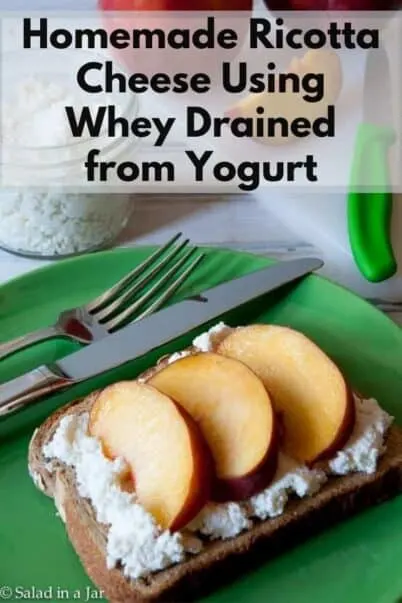
In a stainless steel pot heat the whey. You have to stir this constantly or it.

At that point the small curded proteins will rise to the top of the whey as seen in the photo below.
How to make ricotta from whey. DIRECTIONS This recipe is so simple that it was difficult to get it published here as there is a requirement of a minimum of 3. There is no requirement for the chives or even the salt but I was required to have 3 ingredients. All you really need.
In a stainless steel pot heat the whey. Traditional ricotta cheese is made using whey left over from cheesemaking and it is a wonderful way to utilize whey that might normally be discardedI wanted. Instructions Heat the whey to 195F over medium heat.
Stir constantly to prevent scorching. Remove from heat add vinegar stir and set aside for a few minutes. Line a colander with cheesecloth add the whey.
Whey Ricotta is a very simple cheese both in flavour and technique. With a few simple ingredients you can make this and other variations using our Mozzare. Ricotta is made from whey and it is often drained and taken from various elements overall.
To make this you will need fresh whey milk half a cup of white vinegar and cheese salt. You need to combine whey and milk and you will need to heat the elements to 195 degrees slowly. You have to stir this constantly or it.
In a cheesecloth lined colander pour the whey into the cloth and let the remaining whey drain out of the cloth into the sink or a bowl. It will take about 20 minutes to completely drain and what you will have left. I kept the liquid at a simmer and had cut the potatoes into smaller than usual pieces.
The whey gave the mashed potatoes a marvelous flavor. I also added a couple tablespoons of heavy cream and about a tablespoon of butter. I used 1 12 cups of whey per 1 large russet.
To make the ricotta wait for the whey to cool to a temperature of about 85C add 2 tsp of non-iodised salt then add 2tsp of citric acid slowly and keep stirring until the ricotta curds form. Unlike the lemon juice or vinegar methods adding more whey will not adversely affect the flavour of your ricotta so dont worry. Allow the curds forming on the surface of your pot of milk to be the indicator.
If after 2 minutes curds have not begun to form add another half a cup of whey. You really cant go wrong. Making Ricotta Cheese in a Microwave.
Stir the milk whey and salt together in a microwave-safe container. Heat on HIGH for 18-20 minutes or until mixture reaches 180-190 degrees. This is just a.
How to make ricotta from whey Step 1. Gently heat 2 litres of whey until its almost boiling. If you have a thermometer it needs to be around 90ºC.
The only trick to making sweet whey ricotta is to heat the leftover whey up to 195F. At that point the small curded proteins will rise to the top of the whey as seen in the photo below. At that point the small.
To make ricotta the whey is heated often with fresh milk and citric acid. Then the curds are harvested. If youre making mozzarella you must stretch the curds in hot water.
You can use the whey instead of plain water for more flavor. Traditionally ricotta is made by re-cooking leftover whey from Mozzarella or Provolone cheese-making. What an ingenious way of re-using a waste by-product to make yet another cheese.
Luckily for home cooks who just love ricotta there is a simple milk-based method that doesnt require you to be a cheese maker. Save the whey from making cheese in a non-reactive pot. When you make homemade cheese youll have curds at the bottom of the pot and youll pour off the whey.
Filter as many of the curd particles out as you can since they would otherwise form tough beads in the final ricotta. To make ricotta cheese milk is heated until the curds and whey separate. The curds become the basis for varieties such as mozzarella while reheating the whey produces the moist fine grains that traditionally create ricotta hence the name meaning twice cooked.
How to Make Whey Ricotta. Add milk or cream to whey heat to 200F. Once the mixture hits 200F turn off burner add vinegar and stir.
You will start to notice tiny white particles. Ladle the curds into a colander lined with muslin or a lightweight towel.